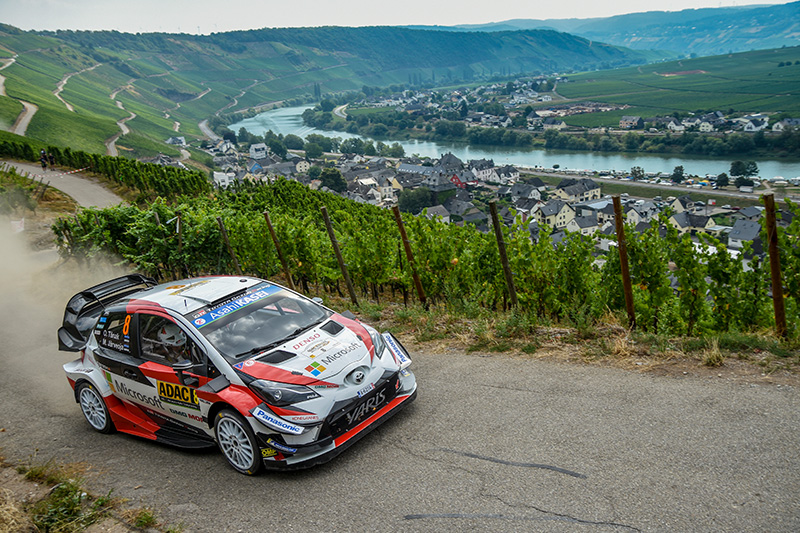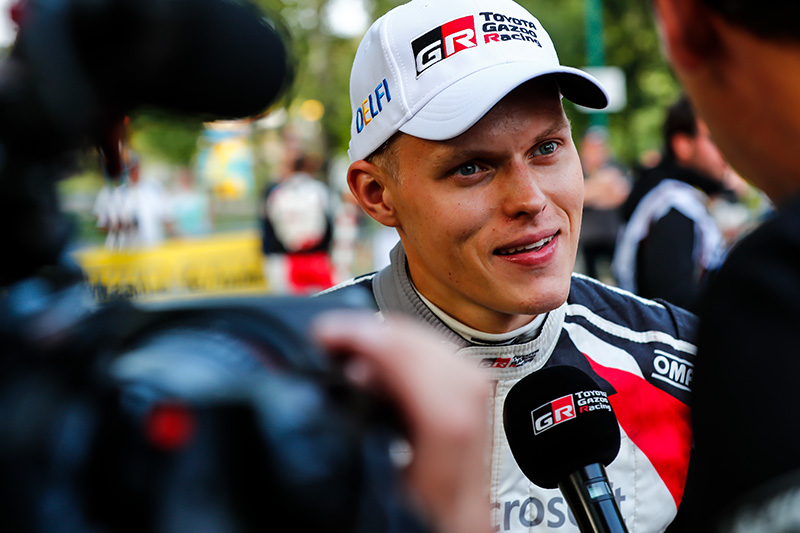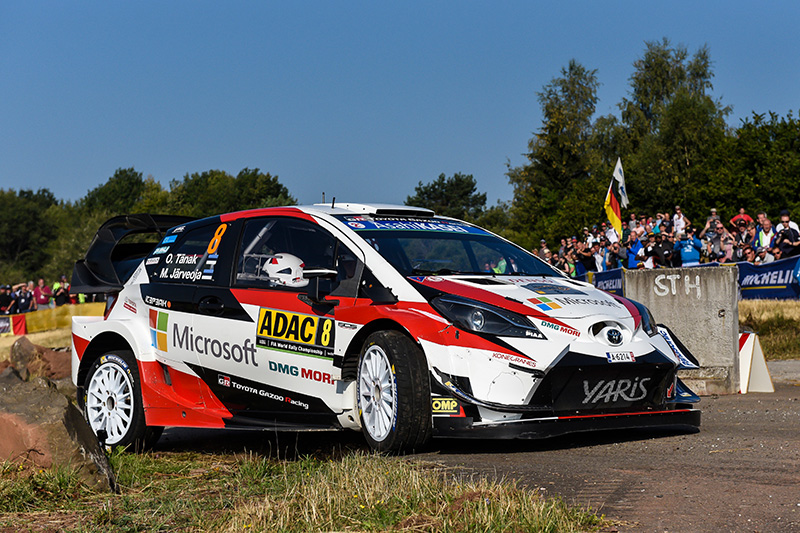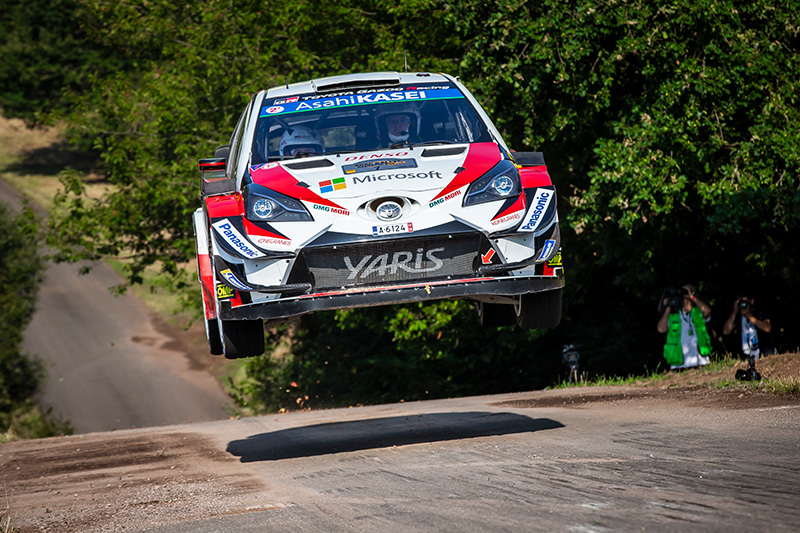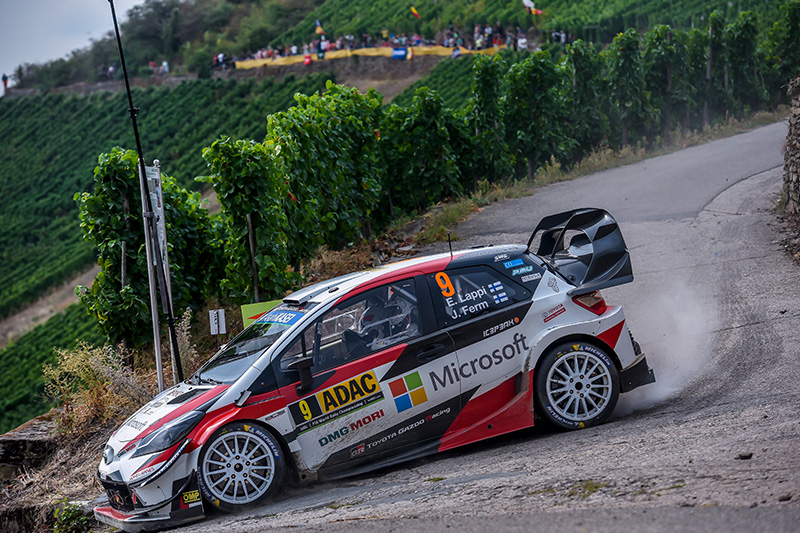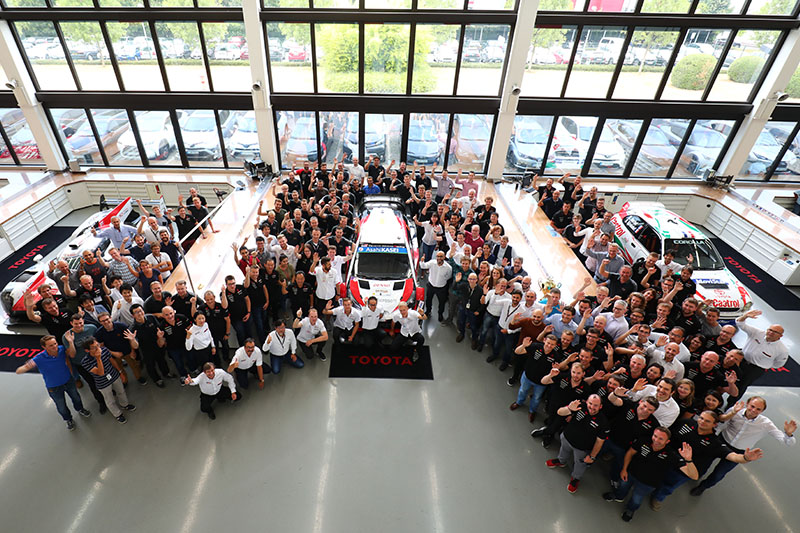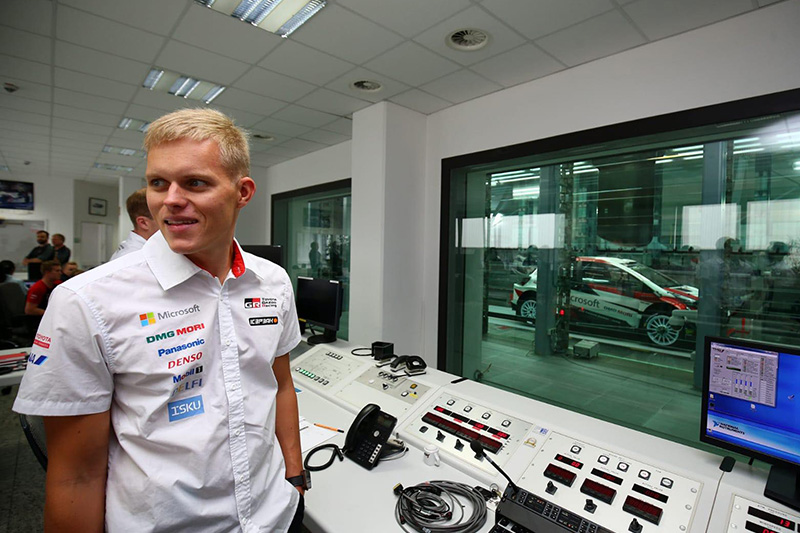RALLYE DEUTSCHLAND

Tänak takes his second victory in a row as he achieved his first win with the Yaris WRC on tarmac
Lappi places third and TOYOTA GAZOO Racing rises to second in the manufacturers’ championship
The WRC takes place in various countries around the world, and is run on a mix of different surfaces: gravel, snow, and tarmac. In 2017, the first year of its return to the WRC, the TOYOTA GAZOO Racing World Rally Team clinched victory on snow at Rally Sweden, then went on to win on gravel at Rally Finland. The team secured victories at gravel rallies thereafter, but tarmac proved harder to conquer.
That is not to say, however, that the Yaris WRC performed poorly on tarmac. Although unique with part snow covered tarmac, Jari-Matti Latvala placed on the podium two years in succession at Rallye Monte-Carlo; Ott Tänak, meanwhile, came second in this year’s edition of Rallye Monte-Carlo, and was again second in round four, Tour de Corse. Evidently, the Yaris WRC was tantalizingly close to victory. In addition, although Esapekka Lappi only came sixth at the Tour de Corse, his speed was palpable as he racked up four Special Stage wins. Indeed, between them, Tänak and Lappi accounted for half of all SS victories at the rally, and the statistics clearly demonstrated the Yaris WRC’s improved performance on tarmac. However, having succumbed to Sébastien Ogier of M-Sport Ford WRT, both team and drivers focused on further improving their performance on tarmac.
Tänak reels off a series of fastest SS times to take the rally lead
Four months after Tour de Corse, the WRC hosted its second full tarmac event and, at Rallye Deutschland, the team’s ceaseless efforts at development would finally bear fruit. In the short, opening SS1, Tänak recorded the fastest time; then on the first stage of Day Two, Ogier went quickest, forcing Tänak into second place in the overall standings. However, on the 22 kilometer-long SS3, Tänak finished five seconds ahead of the second-placed Ogier, so regaining the rally lead. Tänak proceeded to record fastest times in all of Day Two’s remaining special stages, and he finished the day in first overall, with a gap of 12.3 seconds to Ogier in second.
Tänak commented: “This was my first time driving the Yaris WRC on Germany’s unique tarmac roads. However, I felt good from the beginning, and I was able to continue attacking to the end.” Tänak competed in last year’s Rallye Deutschland as Ogier’s teammate, and scored his first tarmac victory in the process. The Estonian has long been friends with the Frenchman—winner of the last five WRC drivers’ championships—and has experienced his prominent speed directly. In order to vanquish his rival and win the tarmac rally, Tänak would have to attack every single stage to the best of his ability; if even for a moment he were to drive defensively, Tänak understood that Ogier would make up the 12-second gap to first place with ease.
Tänak secures his third victory of the season and leads the Yaris WRC to its first-ever tarmac win
The renowned Panzerplatte, which takes place inside the local military training grounds, was one of the highlights on Day Three, but Tänak was slightly off the pace during the morning session. The character of the course on Day Two and Day Three was quite different, and the Yaris WRC had lost some of its outstanding feel from the previous day. In response, the team made changes to the setup of the car during the service break, aiming to optimize the car for the rest of the day’s stages. This enabled Tänak to regain his speed, and he attacked the afternoon’s stages with great confidence. Ogier, meanwhile, with whom the TOYOTA GAZOO Rally driver was locked in a fierce battle, dropped out of contention with a puncture on the first stage of the afternoon. The gap was now some 42.8 seconds to Hyundai’s Dani Sordo, who had taken the Frenchman’s place in second. Tänak’s victory was all but confirmed.
Tänak entered the final day of the rally with an almost unassailable lead and, opting to play it safe, he dropped his pace significantly. On the rally-concluding Power Stage, however, which had bonus championship points riding on it, the Estonian went full pedal. He finished in second place, just 0.1 seconds behind the winner, Ogier. In addition to winning the rally, Tänak therefore accrued an extra four points in the battle for the drivers’ championship.
“The weekend was close to perfect,” said Tänak. “Ogier was genuinely quick, and I had to continue attacking to the best of my ability. This win was a struggle for me, and so it makes victory taste all the sweeter. The Yaris WRC responds accurately to my input, and the updated engine we have been running since the last rally, Rally Finland, is extremely powerful. The team have provided an outstanding car, and I am very grateful to them all.” Tänak secured his third victory of the season, and his second in a row following his success in Finland; as a result, although he remains in third place in the drivers’ championship, he closed the gap to Ogier in second place from 25 points to 13 points. Tänak immediately switched his focus to the next event, the Rally of Turkey: “Going forwards, I intend to concentrate on the battles with great care, one by one, and see how the fight for the championship progresses.”
Mechanical issues snatch an almost certain podium finish from Latvala’s grasp
Tänak led the rally almost from start to finish, but after Ogier’s puncture a fierce battle for second ensued. In pursuit of the second-placed Sordo, a previous winner of the Rallye Deutschland, was Latvala. At the end of Day Two, the Finn was languishing in fifth place; however, he was able to eke out extra speed on Day Three, securing two SS wins as he rose to third and closed the gap to Sordo to just 0.8 seconds. Latvala’s goal was to finish the rally in second place overall. Possessing an extremely good feel for the Yaris WRC, Latvala started Day Four full of confidence. However, as he made his way to SS16, the first special stage of the day, disaster struck: there was an issue with his hydraulic system, and he was no longer able to shift gears with the shift paddles located under his steering wheel. Consequently, Latvala switched to the emergency shifting system—which bypassed the shift paddles—and started the SS. Compared to the shift paddle system, the emergency system was slightly less easy to operate, but it should have enabled the Finn to complete the rally.
Yet, since this emergency shift system was rarely used and since Latvala was in the midst of a full-out attack, an unexpectedly large burden was placed on the drive system, which eventually broke. Latvala was unable to continue, and he relinquished the podium place which had almost certainly been in his grasp. Then on SS16, Sordo, who had been running in second place, crashed and damaged his car and was forced to retire as well. As a result, Thierry Neuville assumed second place. Lappi, who, despite suffering on the difficult road surfaces, had continued to drive at a steady place, scored a best time on SS10 on his way to securing third place; this was his first podium finish since Rally Italia Sardegna, two rounds ago. Thanks to the large number of points amassed by Tänak and Lappi, the TOYOTA GAZOO Racing World Rally Team climbed to second in the manufacturers’ standings, just 13 points behind Hyndai.
The team took one-three finish for the second rally in a row, and now the Yaris WRC had won its first-ever tarmac rally. Team Chairman Akio Toyoda said:
“It is our responsibility to make a car that the driver can drive with full confidence”
“Thank you to all of our team members who made this exciting weekend possible. I would also like to express our appreciation to all of the fans for supporting TGR.”
“This weekend, I truly feel sorry for Jari-Matti Latvala and Miikka Anttila, who could not finish the rally due to a mechanical issue. The other day Jari-Matti told me, ‘The Yaris is a great car that is easy to drive.’ During the rally, he also mentioned that he really enjoyed driving the Yaris, but he regrettably had to end his drive because of a mechanical issue.”
“It is our responsibility to make a car that the driver can drive with full confidence. But we have not accomplished this yet. I feel strongly that we have to make a greater effort, to take this opportunity firmly and turn it into a chance to make ever-better cars. We will continue with a steady focus on creating a car that drivers can enjoy driving with full confidence during championships.”
Using TMG’s wind tunnel facilities, the team aims to realize further improvements
The Yaris WRC has evolved into a car that is capable of winning on all surfaces—snow, gravel, and tarmac. However, there are many issues that still have to be resolved, not least the troubles that afflicted Latvala’s car. In addition, the Yaris WRC remains unable to demonstrate its full potential either at gravel rallies, where there is minimal surface grip, or at rallies that take place in high temperatures. And these are the very sort of conditions that Round 10, the Rally of Turkey, is expected to take place in. For this reason, far from basking in the afterglow of their victory, the team immediately commenced its preparations for the next rally. Special focus is on new initiatives in order to overcome the high temperatures which have been a source of difficulty for the team so far.
The day after Rallye Deutschland, the drivers and other team members visited TMG (Toyota Motorsport GmbH), which is based in Cologne, Germany, to show their appreciation for their efforts. TMG is in charge of developing the Yaris WRC engine and played a critical role in the Round 9 victory. While visiting TMG, the team witnessed with their own eyes that the Yaris WRC was undergoing further evolution: it could be seen in TMG’s wind tunnel facilities, where the aerodynamics of the TS050 Hybrid that conquered this year’s 24 Hours of Le Mans were perfected. The majority of staff at TMG, both Japanese and otherwise, were involved in carrying out wind tunnel tests on the Yaris WRC. According to WRC regulations, aero parts cannot be frequently updated. However, the wind tunnel facilities not only contribute to the development of aero parts, they also enable airflow in the cooling system to be measured. The TOYOTA GAZOO Rally team had visited the wind tunnel facilities at the exact moment TMG was conducting tests on how to effectively cool the engine during high-temperature rallies.
“I was extremely impressed,” said Tänak, his eyes bright with excitement, “to see so many people working hard to develop the Yaris WRC at such splendid facilities as these. I want to record a good result at the Rally of Turkey for their sake as well.”
Tänak had stepped foot inside TMG, including its engine development and wind tunnel facilities, for the first time, and deepened his interactions with the staff who work there. He swore to continue doing his best to realize his lofty goals.
RESULT
| Pos | Driver | Co-Driver | Vehicle | Time |
|---|---|---|---|---|
| 1 | Ott Tänak | Martin Järveoja | Toyota Yaris WRC | 3h03m36.9s |
| 2 | Thierry Neuville | Nicolas Gilsoul | Hyundai i20 Coupe WRC | +39.2s |
| 3 | Esapekka Lappi | Janne Ferm | Toyota Yaris WRC | +1m00.9s |
| 4 | Sebastien Ogier | Julien Ingrassia | Ford Fiesta WRC | +1m34.5s |
| 5 | Teemu Suninen | Mikko Markkula | Ford Fiesta WRC | +2m02.9s |
| 6 | Andreas Mikkelsen | Anders Jaeger | Hyundai i20 Coupe WRC | +2m13.8s |
| 7 | Craig Breen | Scott Martin | Citroen C3 WRC | +2m39.1s |
| 8 | Marijan Griebel | Alexander Rath | Citroen DS3 WRC | +10m41.2s |
| 9 | Jan Kopecky | Pavel Dresler | Skoda Fabia R5 | +13m12.8s |
| 10 | Kalle Rovanpera | Jonne Halttunen | Skoda Fabia R5 | +13m16.6s |
| Retired | Jari-Matti Latvala | Miikka Anttilla | Toyota Yaris WRC |



